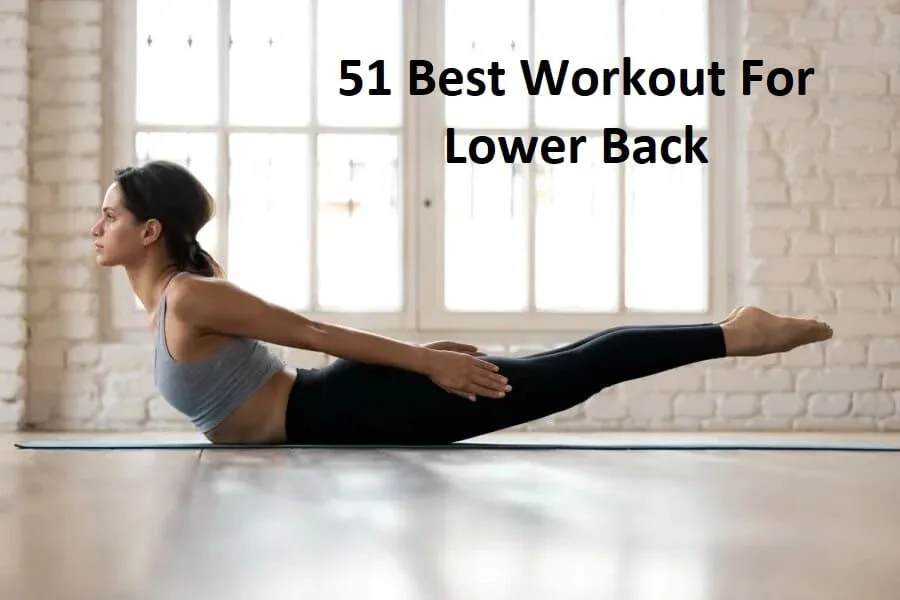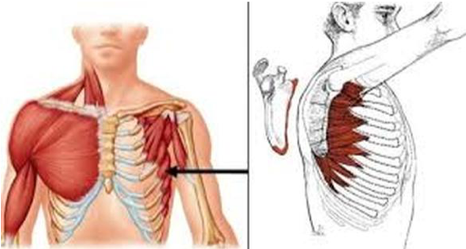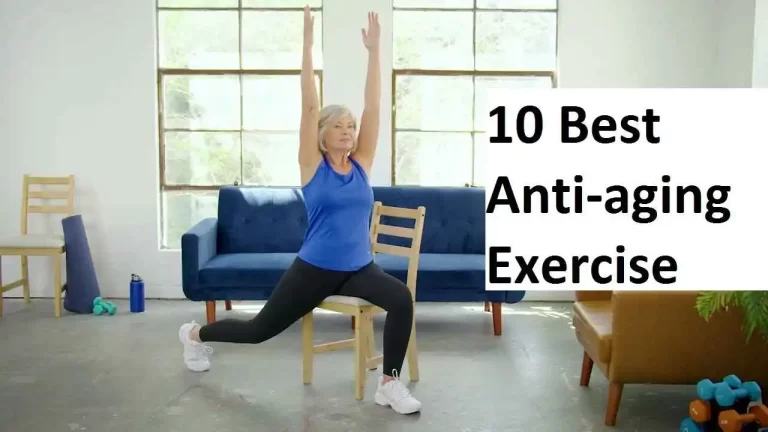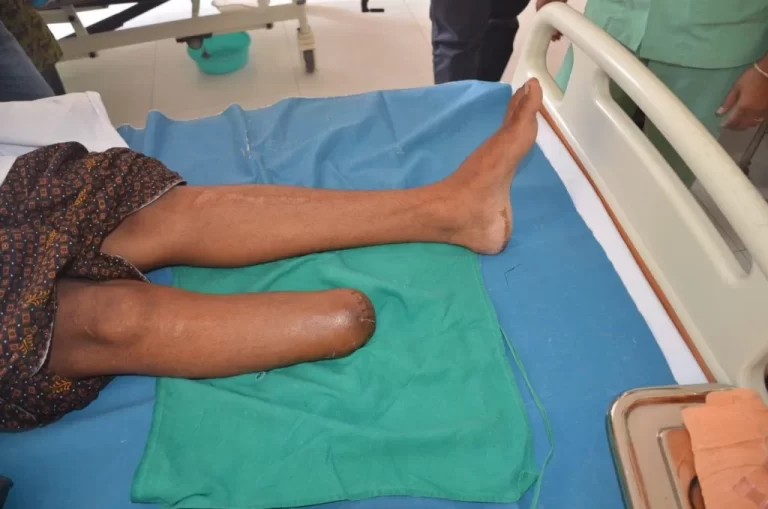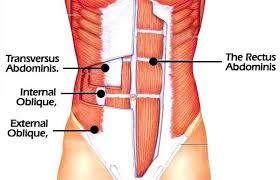51 Best Workout For Lower Back
Table of Contents
Why Workout for Lower Back?
The lower back is a crucial part of our core, supporting our spine and providing stability during various movements. A strong lower back is essential for overall strength, posture, and injury prevention. However, it is also a common area for discomfort and pain if not properly cared for. Engaging in a well-rounded workout routine that targets the lower back can help strengthen and protect this vital area.
In this article, we will explore the best workout for the lower back, focusing on exercises that not only promote strength but also flexibility and balance. By incorporating these exercises into your fitness routine, you can develop a strong and resilient lower back, allowing you to engage in daily activities and physical exercises with confidence and reduced risk of injury.
What is lower back pain?
- A prevalent and painful disorder that affects the lower spine.
- Lower back discomfort is very usual. A strain (injury) to the back muscles or tendons may be the cause of the problem. Disc injuries, structural issues, and arthritis are further factors. Pain is frequently better with rest, physical therapy, and medication. By maintaining a healthy weight and remaining active, you may minimize your chance of developing low back discomfort.
Introduction:
- A strong, fit body composition depends on a strong lower back. The muscle groups in your lower back are some of the most crucial ones in your core. Your risk of lower back discomfort might be decreased by keeping them strong. It also emphasizes how important lower back exercises are.
- When the tendons or muscles in the back are injured, lower back discomfort is a relatively frequent condition. The necessity for appropriate exercise and rest emerges since medications alone cannot treat this issue.
- The most frequent problem that physiotherapists see is back pain, and we just published an article on some easy, common-sense strategies for easing back pain. Another item that should be a regular part of your daily routine is lower back exercises, especially if you are suffering pain or stiffness or as you start to get older. Exercises to relieve lower back pain don’t have to be time-consuming, and just like you should brush your teeth twice a day to avoid issues, stretching and strengthening your back will be beneficial for years to come as the muscles degenerate and your spine becomes less flexible.
- Research has revealed that strengthening your low (lumbar) back muscles and your core muscles is necessary if you want to reduce your low back discomfort. You must concentrate on developing both the deeper, smaller (local) muscles and the larger (global) muscles. All of these muscles operate in concert to support the stabilization of your spine and pelvis, which will lessen low back discomfort, support your spine, and protect against injuries.
- The lower back, sometimes known as the lumbar back, is certainly one of the simplest body areas to hurt. The name “lumbar” comes from the Latin word “lumbus,” which means “lion,” which is appropriate given that many weight lifters suffer injuries while working out their lower backs because they seek out their inner “king of the jungle cat” by pushing themselves harder than their bodies are capable of. You may create the ideal circumstance for a weightlifting-related injury that will make you wish you had kept the beast in a cage by adding a dash of poor form.
- The area of the lower back is one of the most underappreciated and underlooked muscle groups in the body, just it is also one of the most frequent sources of pain.
- I hardly ever see people working out that muscle and there’s a good reason for it because it is not one of the body parts that causes the most problems. This muscle group is crucial for both stability and movement. We would be bent down and more like gorillas than a king of the jungle without a strong lower back.
- You may substantially improve your mobility and get away from the aches and pains brought on by prolonged sitting and poor posture by including one of these low-back exercises in your lower-back workout. However, if you have never worked out your lower back, proceed with caution. To get a sense of how the exercise feels on your lower back, start by lifting low weights or even the bar.
- Exercises for the lower back should ideally concentrate on all lower back muscles on both sides of the spine. The glutes and erector spinae are included in this. Working your upper back and lats as well as the rest of your back is important.
- Consider including these independent exercises in your lower back workout to significantly decrease your risk of back injury and build lower back strength.
- The main lower back muscles, called erector spinae, are smaller and less powerful than the bigger back muscles. As a result, you might need to use lighter weights and perform more reps and sets while working out your lower back.
- The lats, traps, and rhomboids, which are largely located in the mid back and upper back, are the main back muscles that are the focus of most back exercises.
- Exercises for the lower back are also essential to build the erector spinae muscle group, which is essential for supporting your spine.
- For you to be able to smoothly perform other upper-body and lower-body workouts, the most effective lower-back exercises will aid in the development of muscular strength and endurance in these smaller muscles.
- The muscles of the low back, also known as the erector spinae, are in charge of supporting the spine and preserving its shape. When performing actions like bending forward and picking up objects, a strong low back helps prevent injuries and discomfort.
- To reduce discomfort and avoid damage, certain exercises can help the muscles that support the lower back become stronger. These exercises can promote ideal hip alignment and increase core stability and improve physical function.
Strong start
When muscles coordinate their movements, our bodies perform at their best.
Back discomfort or injury can occasionally be caused by weak muscles, particularly those in your core and pelvis.
Daily tasks could be hampered by low back discomfort. Strengthening activities have been showed in research to help reduce low back pain.
- The greatest method to avoid low back discomfort is to have a healthy lifestyle. As you become older, low back discomfort can be reduced by avoiding weight gain, increasing your power, and staying away from dangerous activities.
- Resistance Band Workout for the Upper Body
- Recommended Dumbbell Back Exercises
- Exercise Mobility Routine
- Dynamic and isometric workouts are two methods for strengthening the lower back that has been supported by research. First, whereas isometric workouts stimulate muscles without changing their length (neither lengthening nor shortening), dynamic exercises use the lengthening (eccentric) and shortening (concentric) phases of muscular contraction. Isometric workouts for the lower back have been demonstrated to improve spinal stiffness and stability along with muscle and strength improvement.
- You are likely to believe you have suffered from back pain or discomfort at some time in your adult life. We have all been there, whether it was from a hard workout, lifting something heavy incorrectly, or just sitting in a chair all day. This back pain exercise is for you if such is the case. You may stretch out and engage the muscles you need to avoid pain and maintain your mobility in only 15 minutes.
- Working on your hip mobility and core strength is the greatest method to reduce back discomfort. Since your lower back is a component of your core and your hips and lower back are related, strengthening all of the muscles in that location can help support your back and protect against muscular strain and discomfort.
- If you want to strengthen your glutes, stretch out your hamstrings, rotate your spine, and activate your core, practice yoga for back pain.
Muscle Worked During Back Workout
- While there are many muscles in your back, a great deal of the workouts you perform will mostly target these muscles:
Deltoids
Trapezius
Latissimus Dorsi
Rhomboids
Erector spinae
- Your posture, overall performance, and so many other things depend on the strength of your back muscles. In order to have a great session during your back day exercise, it’s essential that you have a strong basis of motions. You may use these back exercises as an essential component of your training program.
- Although not the most attractive set of muscles, your lower back is one of the most useful. Your spine’s primary part that supports your body weight is called the lumbar area of your back. Therefore, the better your posture, athletic ability, and mobility, the stronger your lower back is. Lower back discomfort will also be less probable to impact you. Because the muscles are deep and supported by other superficial muscles, such as the abs and glutes, it can be challenging to exercise in this area. However, there are a few exercises that you probably already know how to do, as well as some particular lower back exercises that you may add to your repertoire to increase your power and endurance.
- The extensor group acts to straighten (stretch) the spine, whereas the flexor group bends (flexes) the spine. Another group, the iliopsoas, also contributes to the rotation and side bending of the lower back. Together, these muscles are also important for stabilizing and protecting the spine.
Lower Back Muscles
- Understanding your anatomy is essential for getting the most out of your training. Numerous muscles make up this lower back region. When developing your strength, keep in mind two key categories. These are the erector spinae and transversospinalis muscles. The movement of the spine is controlled by both sets of intrinsic muscles, which are found near the vertebrae and deep inside the body. Your abs, glutes, hamstrings, and hips also serve as functional supports for them. They might be difficult to strengthen specifically because of their location, size, and surrounding muscles.
Transversospinalis Muscles
The rotatores, multifidus, and semispinalis muscles make up the three groups that make up the transversospinalis. They stretch and rotate the spinal column as they travel the length of the spine at various levels.
Erector Spinae
The iliocostalis, longissimus, and spinalis are three other muscle groups that contribute to the erector spinae. These also span the length of the back like the transversospinalis groups, but their function is to straighten the spine.
Causes of Lower Back Pain
Lower back discomfort can occur for a variety of causes. Here, a few of these are highlighted.
- Ligament or muscle strain: Back muscles and spinal ligaments can be strained by repeated heavy lifting or by an abrupt uncomfortable movement. Constantly straining one’s back might result in excruciating muscular discomfort if one is not in good physical shape.
- Osteoarthritis: Osteoarthritis is the most prevalent kind of arthritis and can cause lower back discomfort. This degenerative joint condition can occasionally damage the joints in your spine. In turn, this causes excruciating lower back discomfort.
- Osteoporosis: If the bones become brittle and porous, they may eventually break down causing severe pain in the vertebrae of a person’s spine.
- Diseases: Conditions like abdominal aortic aneurysms and kidney stones can cause back discomfort. The other disorders which can cause back discomfort include infections, various forms of cancer, and spine tumors.
- Disk Problems: The disk functions as a cushion for the vertebrae or the little spinal bones. The disks can push on a nerve by bulging from their location in the spinal cord and can create a tear in the ruptured disk.
- Structural Problems: Spinal stenosis is a problem that arises when the spinal column gets too thin for the spinal cord. In such cases, lower back discomfort or severe sciatic pain might arise when something pinches the spinal cord.
- A strained low back muscle, excessive usage, bad posture, wrong lifting technique, and prolonged sitting are a few of the most typical reasons for low back discomfort.
- Women are more likely to suffer from a variety of back disorders than males, especially after menopause. Due to the nature of the female body and the changes you go through as you age, such as hormonal changes, pregnancy, delivery, or weight gain, conditions like sacroiliac joint dysfunction, which can cause lower back pain, or spinal osteoarthritis, which can cause stiffness and discomfort, are more prevalent in women.
- It goes without saying that there are a lot of excellent reasons to maintain a strong and healthy back.
Non-specific back pain may result from:
- Muscular Strains and Spasms
- Degenerative changes and Nerve damage
- Back pain can have a variety of specific and significant reasons, such as:
- Fractures because of compression
- Cancer, Infections, Spondylolisthesis, Neurological problems, and Spinal stenosis
- To build up the muscles that support your spine, try these easy workouts that don’t require special equipment.
- Less discomfort and dysfunction may result from increased strength. Before beginning these exercises, be sure they are appropriate for your particular situation by speaking with your doctor or therapist.
- Of all the spinal segments, the lower back has possibly the most difficult work to do. Despite the lower back’s strength, it is subjected to several stresses, which creates numerous potential for damage. One of the most typical reasons for lower back discomfort is lumbar strain. A lumbar strain is what? Lower back discomfort can result from either overusing or using your lower back incorrectly. Even severe symptoms like muscular spasms might be a result of strains. Repetitive actions, strenuous lifting, or improper body alignment may have led to strains in a muscle or ligament.
- Bulging or ruptured discs between your vertebrae are another potential cause of lower back discomfort. The compression of spinal nerves can result in discomfort, but not always. These conditions are sly, and occasionally MRI scans of individuals with no back pain at all reveal bulged or ruptured discs. Never worry, though, as we have techniques for you to assist strengthen this region of your back.
Risk Factors that Affect Lower back pain:
- Work and lifestyle factors: Jobs requiring bending or heavy lifting might also result in lower back discomfort.
- Weight: Carrying too much weight causes strain on the discs and joints, which can lead to back pain.
- Age: People over 30 tend to have greater back pain because the soft tissues that cushion the spine’s bones weaken with time. When the discs begin to deteriorate and degenerate, the stiffness and uncomfortable worsen.
- Mental health: Depression and anxiety can sometimes cause back pain.
- Overall Health: Sedentary lifestyles, binge drinking, and smoking can all contribute to back discomfort. Abdominal muscles become weak as a result of these actions. As a result, they are unable to support the spine, which causes backaches and strain.
Symptoms of lower back pain:
- If a person has any of the following symptoms, they can determine if they have lower back discomfort.
- Stiffness in the hips, low back, and pelvic muscles
- standing up upright, transitioning from standing to sitting or walking with difficulty
- A lower back ache is an aching or dull
- lower back ache that becomes worse after standing or sitting for a long time
- Lower back discomfort that is stinging and burning extends to the lower foot, legs, and even the backs of the thighs. Sciatica is an additional name for this condition.
Benefits Of Lower Back Exercise:
- Spine strength: Women’s lumbar spines are more stable but less flexible than men’s because they are built to support the uterus during pregnancy, which increases the risk of fractures in women. Activities that strain the spine can raise the risk of damage or even a fractured bone, especially in women who have just gone through menopause. Maintaining this region’s flexibility and pliability will be made easier by strengthening the muscles that maintain the spine straight.
- Better posture: If your back muscles are stronger, you’ll be more inclined to sit and stand up straight. This is because it will simply feel easier because your back muscles will be more active and engaged. This maintains your body in alignment and reduces strain on your ligaments and spine.
- Developing core strength: Your back and core are interconnected and frequently cooperate to support and move your body. Your core strength and performance will increase by working on your back.
- Extra stability: Poor posture and weak lower back muscles might force your body to rely on other, less efficient muscles for stability, which can lead to injury. Your balance and stability will likely improve and your risk of back discomfort will be reduced if you have a strong back and core.
- Boosting metabolism: Increasing muscle mass can also improve your rest metabolism, which will help you burn more calories and manage your weight a little easier.
Some Lower Back Strengthening Techniques
- Exercises for the lower back may not seem like the best way to relieve lower back pain because they put your lower back under extra strain. One of the best back pain treatments, though, is to strengthen your lower back muscles. Additionally, implementing abdominal-focused workouts can support the spine, assist relieve discomfort, and improve posture!
- This exercise program includes some of our top back exercises, which also happen to be the greatest for toning and strengthening the muscles in your upper and lower back, including both superficial (near to the skin) and deep (closer to the bone and internal organs) muscles. These are some of our favorite easy exercises for exercising both the small and major back muscles; this is not a comprehensive list; there are many more excellent exercises, such as back pulls. One more thing to remember about this exercise: moderate stretches like a child’s pose or toe touches will help to reduce discomfort and improve blood flow to your lower back muscles. But strengthening those muscles so you can lessen muscular strain and other symptoms is essential for long-term pain relief. Prepare for a serious back day and lift the bar.
- There are three methods to complete each exercise: Warm-up
Work out
Cool down
Drawing-in maneuver
- The muscle that surrounds the midline is the transverse abdominis. The spine and abdomen are supported.
- It is essential to support the spinal joints and protect them from harm when moving.
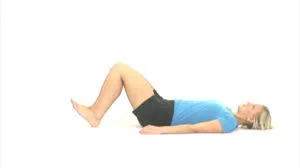
How to do it:
- Lie on the ground with your feet hip-width apart and flat on the ground.
- Keep your hands at your sides relaxed.
- Breathe in deeply. With each exhalation, contract your abdominal muscles without swaying your hips and bring your belly button closer to your spine.
- Take a 5-second hold.
- Five times in a single day.
Lying lateral leg raises
- Your leg can be raised to the side and away from the body with the aid of the hip abductor muscles. They help to support your pelvis when you’re standing on one leg.
- If these muscles are weak, it might affect how you move and balance. Instability might also result in low back discomfort.
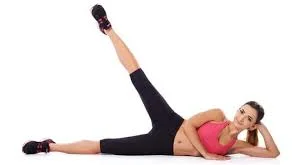
How to do it:
- Your lower leg should be slightly bent on the ground while you lie on one side.
- Bringing your belly button closer to your spine might help you build core strength.
- Without moving the rest of your body, lift your upper leg.
- Hold the top position for two seconds. 10 times in total.
- Repeat on the opposite side. Perform 3 sets for each side.
Supermans
- Along your spine, your back extensors are located. They let you stand upright while supporting your spine and pelvic bones and allowing you to bend your back.
- Stop doing this exercise if it makes your back discomfort worse until you have a more thorough assessment. To rule out more serious reasons for your back discomfort, consult your doctor.
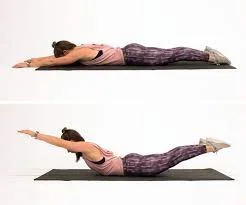
How to do it:
- Reach your arms forward and your legs back while you simply lie there.
- Legs and arms should be spread out to the width of the hips and shoulders, respectively.
- To contract your abs, pull your belly button in and away from the floor.
- Reaching your arms up off the ground and lifting your legs off the ground should be done while relaxing your shoulders.
- Keeping the abdominals contracted will help you avoid placing too much strain on the low back.
- The calves up to the upper back muscles, which make up the back of the body, will all be active.
Weighted Superman
- The Superman is a bodyweight exercise for the erector spinae, which are lower back extensors.
- As you gain strength, you may increase the weight on your upper and lower bodies by using dumbbells or medicine balls for the upper body and ankle weights for the lower body, respectively.
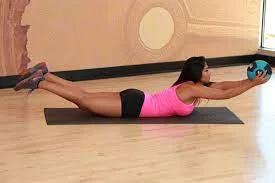
How to do it:
- Holding a dumbbell or medicine ball in between both hands while lying on your stomach with your arms raised overhead.
- Only your stomach and the tops of your hips should remain on the ground, so contract your glutes and lower back muscles to lift your upper body, head, and chest along with your lower body.
- When you pick up and lift the weight, keep your arms straight.
- Hold the highest position for two to three seconds before lowering back down.
Partial curls
- The abdominal muscles play an essential part in supporting the spine. Having a strong core may keep your hips aligned correctly. This could strengthen your core and help you maintain stability.
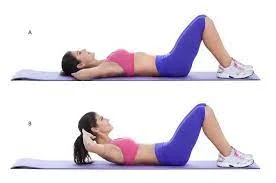
How to do it:
- Your feet should be flat on the ground while you lie on the ground with your knees bent.
- Put your hands crossed over your chest.
- Breathe in deeply. Pull your belly button towards your spine to tighten your abdominals as you exhale.
- Lift your shoulders just a few inches off the floor gradually. To prevent pulling up your neck, try to keep it in a straight line with your spine rather than curving.
- Go back to your starting point.
- Ten times in total. Make three sets.
Deadlift
- The standard back exercise is the deadlift. There aren’t many exercises that use as many different muscles at once as a conventional pull from the floor. This makes it a terrific approach to exercise your lower back by default, especially if you’re new to bodybuilding or weightlifting.
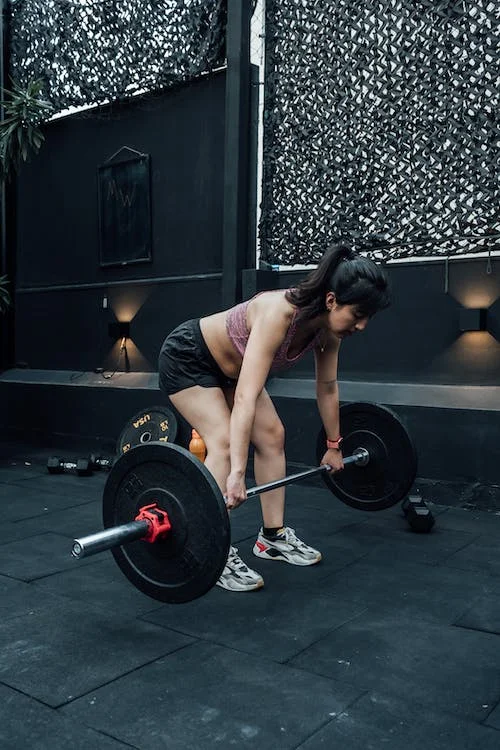
How to do it:
- Put your feet hip-width apart and stand in front of your bar. At the bottom of the exercise, your knees will be bent.
- Using an overhand grip with the bar at shoulder width, hold it.
- When you are standing up straight with your arms down by your sides and the bar lying in front of your thighs, pull the bar straight up.
- Your body will tilt at the hips after initially straightening your knees. When completing this movement, remember to maintain your back and neck as straight as you can.
- You will feel a slight concentric contraction in your lower back when performing this technique while vertically upright.
- With control, bring the bar back to the ground.
Stiff-Legged Deadlift
- In order to emphasize your lower back even more, you might adapt the deadlift, which is a good variant for pulling strength. Deadlifts with stiff legs almost eliminate the need for your legs, allowing you to concentrate on developing your lower back.
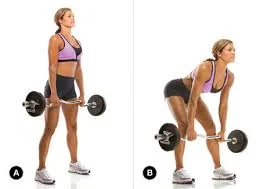
How to do it:
- With your feet between your hips, your back straight, and your hands on the bar just outside your thighs, position yourself as you would for a regular conventional deadlift.
- To raise your hips so that your torso is parallel to the floor before you lift, extend your knees.
- Perform a deadlift from here.
- From a standing posture, gradually decrease the weight with an emphasis on tipping over at the waist.
- The majority of the way, your hips should remain at the same level.
Single-Leg Romanian Deadlift
- There should be at least one single-leg (or single-arm) exercise in every effective session. You may pinpoint, target, and correct muscle strength or size imbalances using unilateral exercise. Try the Romanian deadlift with one leg to strengthen your lower back.
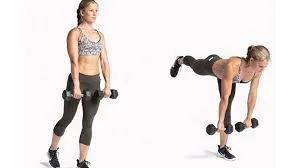
How to do it:
- Standing straight, place most of your weight on one leg while holding a barbell.
- From this position, slowly tip into a hip hinge while letting your non-working leg rise off the ground.
- As you fall over, your non-working leg should be equally straight and travel behind your torso.
- Reverse the action and stand up when the muscles in your working leg feel lovely and stretched.
Barbell Romanian Deadlift
- This exercise targets the lumbar extensor group and works the lower back isometrically. The muscles of the lower back stabilize the spine throughout both the lowering and increasing stages of the Romanian deadlift. One of the finest workouts for the lower back, as well as the hamstrings and glutes, which stretch the hips during this exercise, is this one.
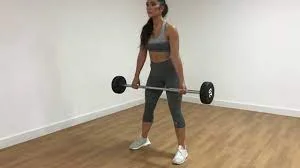
How to do it:
- As you begin, stand straight and grip the barbell with your arms at your sides and the bar in close proximity to your body.
- Next, bend your knees slightly.
- Now, slowly hinge your hips by pushing them backward while maintaining a rigid neutral spine and without bending your knees more.
- Keep your body in touch with the bar.
- Only hinge as far back as your hips can go.
- Then, drive your hips forward while concentrating on tightening your glutes until you are back in the upright starting posture.
Conventional Deadlift
- A conventional deadlift works for the extensor muscle group isometrically through spinal stability, much like the Romanian deadlift does. Because conventional deadlifts work many joints, they also train and develop a variety of muscular groups, including the legs, back, glutes, and hamstrings.
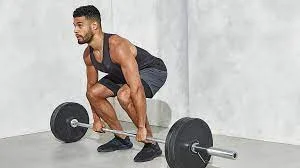
How to do it:
- Start with the bar caused up near your shins and your feet at shoulder-width apart.
- Next, take an overhand hold on the bar just outside of the shins.
- Hinge your hips by pulling them rearward while holding the bar.
- Your hips should be lower than your shoulders, and your shins should be vertical.
- Maintain a neutral head posture.
- Just before lifting, flex your back (lattissium dorsi) by visualizing the bar being bent.
- Drive the floor away by pressing your feet into the ground as you raise.
- Next, move your hips forward while contracting your glutes.
- From the top position, keep your spine neutral and flex your hips backward to drop the bar.
- Keep your body in touch with the bar.
Trap Bar Deadlifts
- While you can do deadlifts with a conventional barbell, a trap bar allows you to use a neutral grip, which lessens the strain on your upper body and allows you to lift more weight.
- Greater improvements in bulk and strength throughout the entire posterior chain may result from this.
- When you complete a hip hinge, your low back muscles must tighten in order to keep your spine stable.
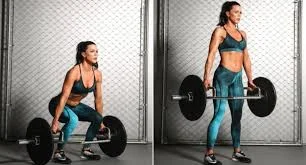
How to do it:
- Your toes should be facing straight forward when you stand inside the weighted trap bar with your feet hip-width apart.
- Squat down and grab the grips of the trap bar as you do so, bracing your core.
- By activating your glutes and hamstrings, you can straighten your back while extending your hips and knees to stand up.
- Sit back and gradually lower the bar until it is at your ankles.
Barbell Row
- You must exercise the several various muscles that make up your back. The barbell row is an efficient and effective exercise that trains your entire upper back at once.
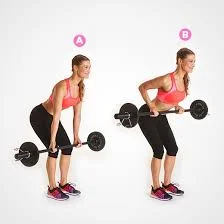
How to do it:
- In a double-overhand, shoulder-width grip, take a barbell from a rack.
- When the bar is directly beneath your shoulders, tip over at the hips and let it float down your thighs.
- From this position, draw with your elbows while pulling your scapulae inward to row the bar into your lower stomach.
Barbell Good Morning
- This exercise works your lower back like crazy while also showing respect. The good morning uses physics to exaggerate the weight of even an empty barbell. Try this workout if you don’t have much access to weights or if you want to improve your back squat while toning your spinal erectors.
- As these muscles operate in the good morning posture to stabilize the spine when the hips are hunched, they act isometrically in this exercise to strengthen the extensor group of the lower back. As they extend (push) the hips forward during the concentric (shortening) phase, the glutes and hamstrings are also worked.
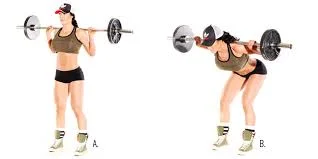
How to do it:
- Just below shoulder level on the squat rack, place the barbell.
- Lift the barbell off the rack using your upper traps.
- In order to have enough space, take a few steps outside the squat rack.
- As you tilt at the hips until your torso is almost parallel to the floor, let your knee slightly bend.
- To bring your body back up to a standing posture, contract your glutes and hamstrings.
- To start the following exercise, carefully adjust your hips and torso into their starting positions.
Back Extensions
- One of the most well-known lower back workouts is certainly back extensions. They are effective in strengthening the erector spinae, a muscle that goes up and down your spine. Your back may be straightened and rotated with the help of this muscle.
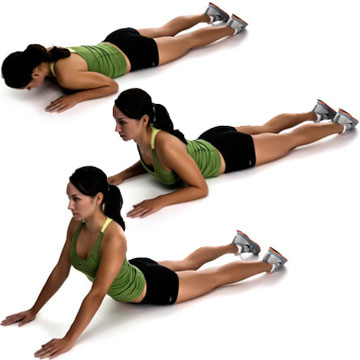
How to do it:
- Lie on your back to perform back extensions. Keeping your legs flat on the ground, raise your chest.
- By keeping your hands on the ground, behind your head, or out in front of you, you may support yourself.
- For a more challenging exercise (sometimes referred to as the Superman), you can also raise your entire body at once.
- When performing back extensions, the main secret is to contract your abs before lifting your chest off the floor.
- You’ll be able to concentrate on your lower back muscles.
Back Extensions on a Ball
- On an exercise ball, back extensions provide you with a wider range of motion. By attempting to maintain your balance while using a ball, you may also develop your core. Strengthening the core also strengthens the back, which helps with balance and stabilization.
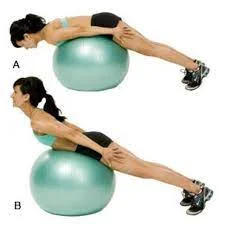
How to do it:
- You can either place your hands on each side of your head or maintain them tucked under your chin.
- Round over the ball completely, then elevate your upper body into a straight line by contracting your abs.
- As a variation, you may perform this exercise while on your knees.
Stability Ball Back Extensions with weight
- You may incorporate this exercise into your lower back exercises even if your gym lacks a hyperextension machine.
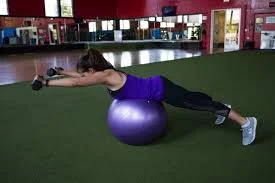
How to do it:
- So that you may hang on to the bench’s legs, place a stability ball at the side of the weight bench.
- You should hold a dumbbell on your arm.
- Your hips should be just barely off the ball when you lie facedown on it with the ball on your tummy.
- Maintaining your legs straight, tighten your glutes and lower back muscles to raise them as high as you can while still keeping your glutes completely engaged.
- Straighten your legs as you slowly reposition them.
45-Degree Back Extension
- To develop your lower back, look for workouts that combine isolation and compound movements. Although focusing on the lumbar spine is more challenging than, for example, working on your biceps, you can still get in a great workout if you have access to a back extension station.
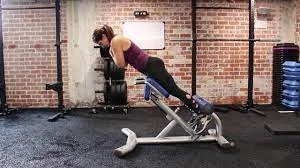
How to do it:
- Place yourself inside the device. The top of the thigh cushion should fall precisely below the line where your hips fold.
- Your torso may be lowered by bending at the waist.
- Reverse the action after you’ve reached the bottom and lift your body back up using your lower back.
- Consider purposefully curving and uncurling your spine as you move in order to draw attention to your lower back more than your glutes or hamstrings.
45-Degree Low Back Hyperextension
- Targeting the lower back’s extensor group, this dynamic workout. It exercises the glutes and hamstrings and provides a full range of motion for the low back.
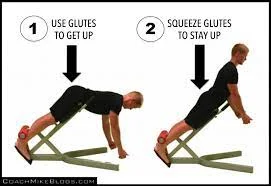
How to do it:
- Put the bench hip rest in place first, slightly above the top of your pelvis.
- Start with your chin pulled and your spine in a neutral position.
- Next, progressively circle your lower back while keeping your hips straight.
- Next, raise your head while hyperextending (arching) your lower back.
Hyperextension
- Because of how violent the term “hyper” sounds, hyperextensions have a poor reputation. However, this exercise is fantastic for building lower back strength. You receive a full flex as well as a contraction of your muscles in the concentric direction, and you can easily add weights to improve your results. Lifting your body to a neutral posture rather than completely stretching is the key to doing the exercise without placing unnecessary strain on your lower back. Without taking needless risks, you nevertheless receive engagement across the whole range of action. By using dumbbells as your weights and adding a row at the top to incorporate your upper back muscles in the workout, you can take your extension to the next level.
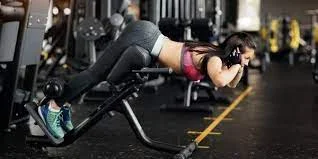
How to do it:
- In order for you to quickly acquire your selected weights, have them available on the floor in front of the ham-glute machine.
- Put your body in the machine such that you are hip-hinging.
- Your back should be fully extended as you crouch down until your body is parallel to the ground.
- If you use weights, take them with you now.
- To raise your torso and make sure your body is straight, concentrate on utilizing your back.
- Keep your back as straight as possible. Add a row at the top to simultaneously train your upper back muscles.
- Retract your steps while maintaining control.
Reverse Hyperextension
- This exercise can help you achieve your bodybuilding objectives more effectively than any other if you have access to a glute-ham developer or, even better, a reverse hyper station. Additionally, it works well as a prehab technique. To hollow out that Christmas tree and protect your spine, perform a reverse hyperextension.
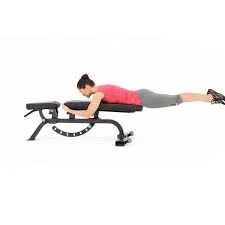
How to do it:
- As you lean back on the chest pad, let your legs swing freely behind you.
- The exercise is straightforward from here on out: raise your legs till they are squarely behind you by using your glutes and spinal erectors.
- The most essential thing to remember is to avoid swinging with too much momentum. Keep your knees locked the entire time.
- Control the rate at which you drop your legs by bending your lower back.
Reverse Hyperextension on the Ball
- The lower back may be worked in an unusual method with this exercise. Your back muscles are used to elevate your lower body rather than your upper body. This exercise strengthens your glutes and hamstrings in addition to your back.
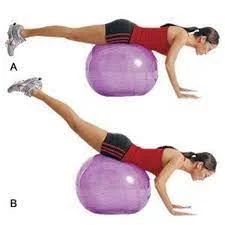
How to do it:
- Place the ball under your chest while lying face down to do the reverse hyperextension.
- Roll the ball beneath your hips as you go forward on it.
- Lift your legs towards the sky while maintaining their straightness until your body is in a straight line.
- By moving forward further farther until your forearms are resting, you may make this maneuver more challenging.
Back Extensions on the BOSU
- A BOSU balance trainer, if you have access to one, is a fantastic tool for strengthening your entire core, particularly your lower back. Similar to an exercise ball, the BOSU helps you develop strength as you strive to maintain balance while moving.
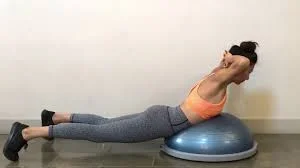
How to do it:
- Place the BOSU under your hips while lying face down.
- Next, move your upper body off the trainer and carry out the lower back exercise as you would on an exercise ball.
- While balancing on the shaky dome will present a completely new set of challenges for your core and stability, you’ll have a bit less range of motion.
45-Degree Side Bend
- This dynamic workout concentrates on the lower back’s side-bending iliopsoas muscle group. One of the finest exercises for the lower back is the 45-degree back extension, which aids in stabilizing the hips and legs and allows the lower back to bend to the side fully.
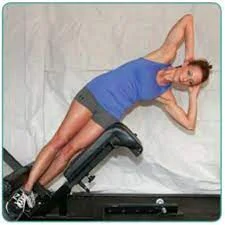
How to do it:
- Start by anchoring each foot beneath the foot pads by scissoring your legs.
- Place the bench hip rest in this position: slightly above the pelvis.
- Put your head and spine in neutral to begin.
- Next, bend your body as far to the side as possible at the torso without bending forward.
- Reposition yourself to a neutral position after that.
Jefferson Curl
- You must become used to some degree of lower back mobility under stress if you want to strengthen and develop your lower back. Despite what many people think, spinal flexion is not necessarily dangerous.
- However, exercising in and out of lumbar flexion is something that most athletes are not used to doing. As a result, an exercise like the Jefferson curl may impart stimulation to the target muscles with unbelievable effectiveness. All you have to do is move slowly and put emphasis on proper form.
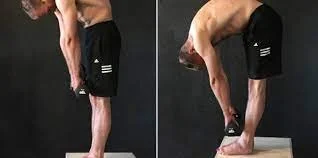
How to do it:
- With an empty barbell or even something lighter (like a PVC pipe) at first, stand up straight.
- From here, round your upper back over to start the Jefferson curl.
- The pipe or barbell should start to slide down your thighs.
- Up until the bar touches the floor or your hamstrings feel noticeably stretched, keep rounding your back.
- You should stretch your spine from top to bottom.
- Return to a standing posture by reversing the action and gently and deliberately unfolding your spine.
Nordic Hamstring Curl
- Similar to the good morning barbell exercise, this isometric exercise targets the extensor group. Here, an isometric contraction of the lower back muscles stabilizes the spine through the eccentric (spine-lengthening) and concentric (spine-shortening) phases of the lift. In this workout, the hamstrings are also specifically targeted because of their function as knee flexors.
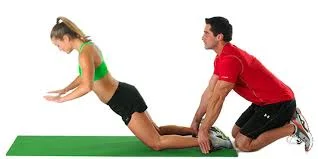
How to do it:
- To begin, kneel down with your torso straight and high.
- Straighten your arms so they are at chest level in front of your body, as if performing a press-up.
- Now put your feet under something strong to increase stability.
- Straightening your legs (there shouldn’t be any bending at the hips) will help you progressively lower yourself to the ground while maintaining a neutral spine and your arms out in front of you.
- When lowering, let your arms absorb part of the impact.
- After then, return to the starting position by bending your knees (imagine kicking your heels up to your butt).
Swimmers
- The rear of the body is trained to work against itself during this exercise to enhance balance, spinal strength, and mobility. very much like the Superman workout.

How to do it:
- Starting out, you’ll sleep on your stomach.
- This time, lift the right arm and the left leg off the ground before switching. Do not lift both arms and legs at the exact same moment.
- Make careful to keep pulling your abs in throughout.
- Each side deserves 10 reps.
Bird Dog
- Your glutes, deep core muscles, and erector spinae in your back are all strengthened by the bodyweight core exercise known as the “bird dog.”
- As you gain strength, you can use light dumbbells in your hands and ankle weights to assist strengthen your lower back.
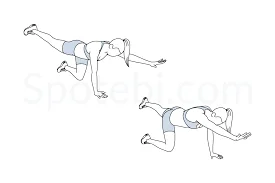
How to do it:
- Kneel on all fours with a flat back, wrists stacked under shoulders, knees stacked under hips, and assume a tabletop position.
- Lift and extend your opposing arm and leg at the same time while keeping your core engaged.
- Lift your leg straight back so that it is parallel to the floor and extend your arm forward so that it is straight and parallel to the floor in front of your head.
- Before bringing your hand and leg back to their beginning positions, move them past neutral so that your elbow and knee contact each other below your torso.
- Slowly and methodically make your way back to the starting position.
- On the other side, repeat.
- Continuously switch sides.
Glute bridge/Bridges
- A great lower back exercise for corrective purposes is the glute bridge, which works the muscles with a low-intensity, high-volume action. As your hips approach their maximum range of motion, use your back muscles to move the extension. The greatest method to get the necessary engagement is through this. Bridges simultaneously exercise your glutes. This is excellent because it will give you a strong, toned butt because your glutes are one of the several muscles that support your lower back.
- The gluteus maximus is the name of the large muscle in the buttocks. One of the body’s strongest muscles is it. Exercises like squatting and other hip extensions are controlled by hip mobility.
- Back discomfort might be aggravated by gluteus weakness. This is because they have a critical stabilizing function for the lower back and hip joints during movements like walking.
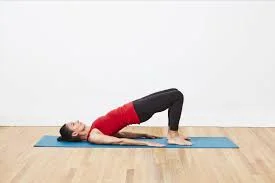
How to do it:
- When your knees are bent, your feet should be flat on the ground.
- As you press the ground with your low back, engage your core.
- Then, raise your hips towards the sky while slowly curling your back off the ground.
- Avoid overextending your back by not lifting too high.
- Stop when the line drawn by your hips from your upper back to your knees is straight.
- Hold the posture and then gradually return to the beginning position.
- Ten times should be repeated.
Single-Leg Glute Bridge
- Another easy, moderate exercise that is great for strengthening the lower back is the single-leg glute bridge. The hamstrings and glutes benefit as well, further strengthening the core’s stabilizing muscles.
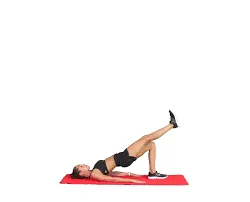
How to do it:
- Lie on the floor on your back with your feet flat on the ground and your knees bent. Your fingertips should almost touch your heels while holding your hands at your sides. Put your back on the floor and use your core.
- In this position, lift your right foot off the floor and extend your right leg.
- As you elevate your hips and perform a glute bridge, push off your left foot, tighten your abs, and squeeze your glutes.
- Gradually lower your hips to the ground.
- After finishing each rep on one side, move to the other.
Side Bridge
- The iliopsoas muscle group is also targeted by this isometric workout. In addition to promoting the growth of these muscles, it also improves spinal stability.
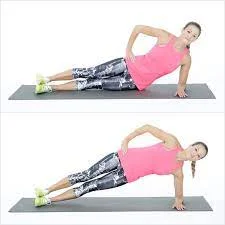
How to do it:
- First, position yourself on your side with your legs straight and your feet scissored. Put your weight on your elbow.
- Your free arm should be placed on top of your lower shoulder.
- Next, lift your hips off the floor so that your body is supported exclusively by your feet and arms.
- Maintain a neutral spine and head posture.
- Hold this posture for around 7 to 8 seconds before switching sides.
Glute Bridge With Pulse
- Leg Bridge Along with the glutes, Pulse also targets the hamstrings, lower back, and abs. The glute bridge has numerous advantages that are comparable to those of a squat, but it also has the advantage of not putting any strain on the lower back.
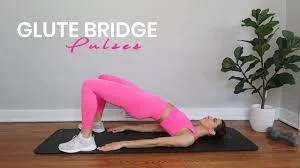
How to do it:
- Your fingertips should touch your heels while your arms are at your sides.
- Your feet should lie flat on the floor, your knees bent, and your heels spaced a few inches from your butt.
- Using your glutes, core, and heels, raise your hips off the ground until your body is straight from your shoulders to your knees.
- Squeeze your glutes to raise your hips a few inches higher towards the sky and then lower them to their starting height as you pulse at the top.
- For the duration specified, continue to pulse regularly.
Glute Bridge March
- Leg Bridge It’s an excellent month to concentrate on your core and glutes. hamstrings, glutes, and hip abductors should all be stretched. The quadriceps and obliques become more stable.
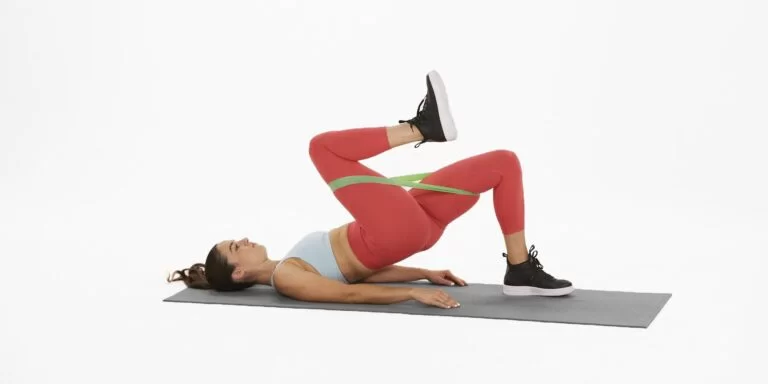
How to do it:
- Your fingertips should touch your heels while your arms are at your sides.
- Your feet should be level on the floor, with your knees bending and your heels a few inches from your buttock while you lie on your back.
- Keep your knees close to one another while lifting your hips; avoid letting your legs spread apart. Squeeze your glutes, strengthen your core, and elevate your hips.
- While keeping your hips up, march first with your right leg and then your left leg.
- Put both feet back on the ground after finishing each rep, then slowly drop your hips to go back to the beginning position.
Forearm plank
- A forearm plank is a core body exercise that promotes body stabilization, strengthens your low back, and activates all of your core muscles. The key muscle that gives you a flat stomach is the transversus abdominus, which is frequently ignored.
How to do it:
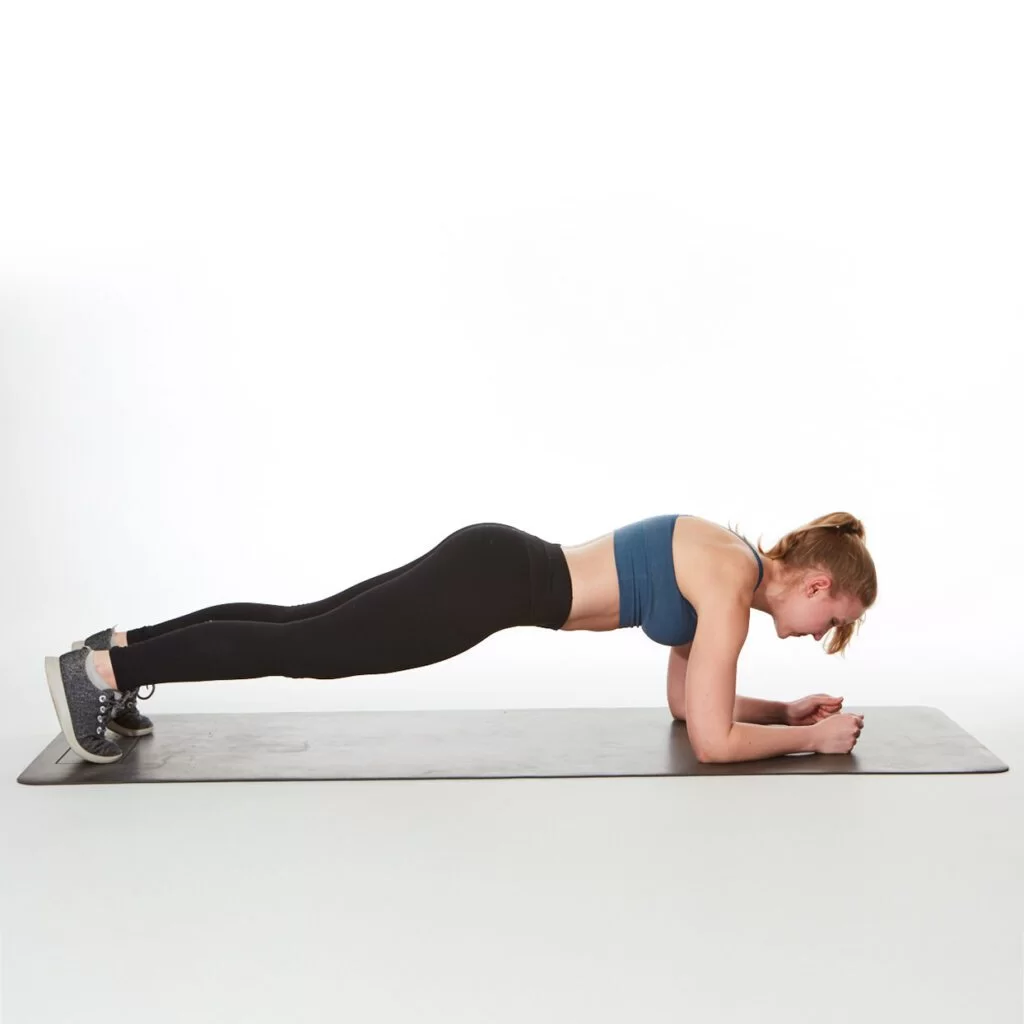
- Start out on the mat, bending your knees and hands at your sides.
- Put your wrists over your shoulders. Drop to your forearms and forward your knees a little distance.
- Tuck your toes in, raise your legs off the floor, and draw your navel in towards your spine.
- Reach your heels back towards the back of the room while contracting your quads.
- Check yourself in the mirror, if you have one, to make sure you’re walking in a straight path.
- Keep your back straight while using your core.
- For 30 seconds, maintain the posture.
- After a break, repeat.
Side forearm plank
- You can strengthen your glutes, hips, and shoulders while also developing a strong, stable core with the aid of the straightforward yet powerful exercise known as the side plank. This can not only prevent pain from developing in the first place but also aid to lessen discomfort in the muscles in certain regions.
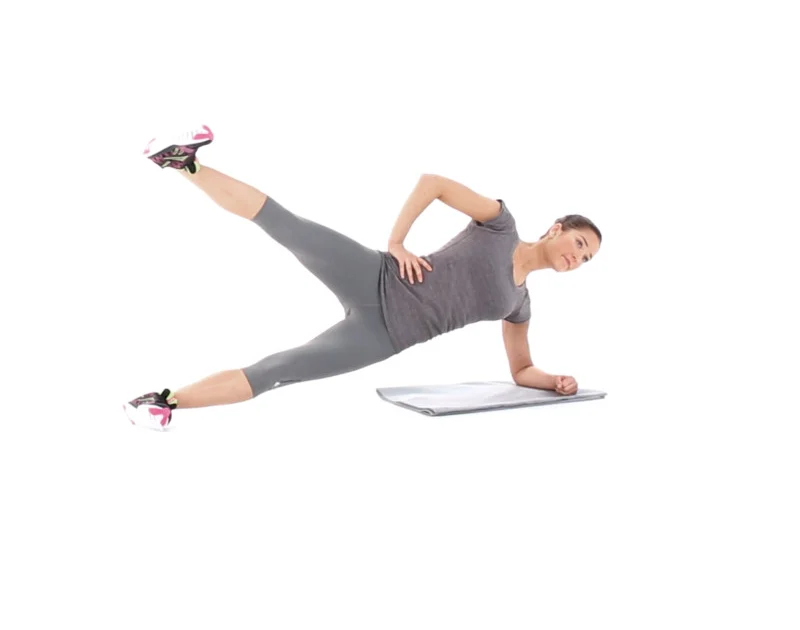
How to do it:
- Turning your body to the left while supporting your weight on your right forearm and the outside of your right foot, start in a forearm plank posture.
- Keep your left arm bent as you raise it into the air.
- To work the full right side of your body, put your left foot on top of your right and lift your right side off the floor.
- Repeat on the other side, then return to the forearm plank.
- 10 repetitions on each side, continue switching sides.
Side plank
- The side plank is a common exercise for oblique or core exercises, but it’s also a wonderful exercise for lower back exercises.
- For the duration of the plank hold in this exercise, your lower back muscles must contract isometrically to stabilize your spine and maintain good posture against gravity.
- The main advantage of using the side plank in your lower back workouts is that it helps your lower back muscles get stronger to resist lateral flexion rather than anterior flexion, which is what most lower back exercises instead emphasize.
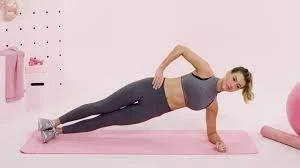
How to do it:
- Your legs should be placed on top of one another while you lie on your side.
- Your entire body will lift into the air as you push up and straighten the arm on the side of your body that is lying on the ground. Your leg and arm remain straight, while your feet continue to be piled on top of one another.
- Maintain a bodily alignment with your hips.
- For 30 to 60 seconds, maintain this stance.
Dumbbell-free renegade rows
- Renegade rows are full-body workouts that simultaneously work the triceps, rhomboids, and obliques, as well as other key muscle groups in the back and arms.
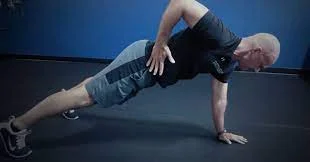
How to do it:
- Start by standing on a high plank.
- Before lifting one of your hands off the floor, hug your elbow in towards your side to activate your upper back, then raise the hand up to your shoulder.
- Once back in the beginning position, move the opposite arm in the same way.
- Count 10 times with each arm.
Cat cow exercise
- You may enhance your balance and posture by performing the cat-cow stretch. Due to the connection between the motions and breathing, it is also said to be a relaxing and stress-relieving position.
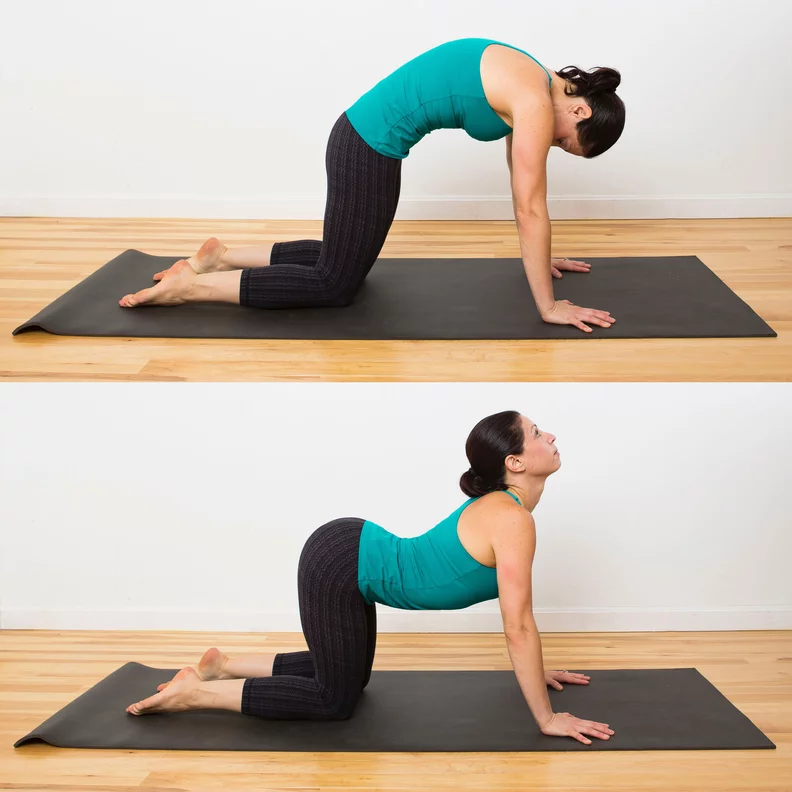
How to do it:
- Begin on your hands and knees, placing your knees precisely behind your hips and your hands flat on the ground beneath your shoulders.
- Breathe in, lower your stomach towards the floor, look up towards the ceiling, and arch your back to enter the cow position.
- Pulling your belly button towards your spine and arching your back upwards towards the ceiling, assume the cat stance as you exhale.
- Your head should droop towards the floor.
- Ten times in total.
Pilates half roll down
- Whether you are new to Pilates or an experienced practitioner, you may perform the roll-down. It develops the abdominal muscles and relaxes the neck and shoulders, where we tend to hold a lot of stress.
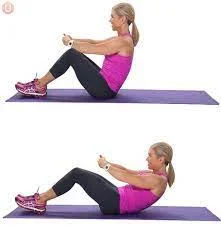
How to do it:
- Kneel down on the ground while seated. You may advance this workout by straightening your legs.
- Next, extend your arms in front of you while keeping your shoulders relaxed.
- Roll carefully onto your low back while pulling your naval towards your spine.
- After pausing, raise yourself back to the starting position gradually.
- Ten times in total.
Cobra exercise
- After a challenging abs workout, the Cobra Exercise is an excellent follow-up exercise that may help increase trunk flexibility and mobility.
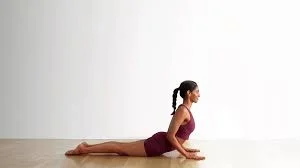
How to do it:
- Take a yoga mat and lie on your stomach.
- Lie down on the mat with both hands facing down, just below your shoulders.
- Keep your elbows tucked into your sides while giving them a little bend.
- Exhale after taking a breath in and lift your chest off the mat.
- Roll your shoulders back while maintaining a neutral neck.
- For at least 30 seconds, maintain the position.
Kettlebell Swings
- Swinging a kettlebell is an active metabolic, all-body workout. Kettlebell swings are an excellent move to incorporate into your lower body exercises even though they aren’t necessarily an isolated lower back exercise because they still call for a lot of erector activation.
- Similar to the deadlift, every rep of a kettlebell swing includes a hip hinge, which calls for hard contractions from your lower back muscles to support the stabilization of your spine.
- Additionally, kettlebell swings are an effective approach to increase the endurance of your smaller lower back muscles since they are performed quickly and often for a longer amount of time.
In fact, research has shown that the kettlebell swing exercise is a very excellent workout for enhancing functional strength and lowering the risk of low back discomfort. - As a result, adding this exercise to your lower back workouts is one of the most beneficial moves.
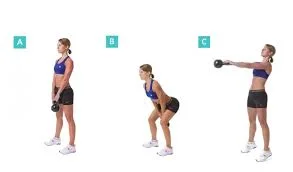
How to do it:
- Stand holding an easily heavy kettlebell in both hands with your feet somewhat wider than shoulder-width apart.
- In order for the kettlebell to hang down in front of your body, your arms should be completely extended.
- Keep your heels firmly on the ground and bend your knees slightly.
- Drive the kettlebell up until it is around chest height and your arms are completely stretched out in front of you by pressing from your heels and exploding through your hips.
- Make careful use of your glutes and core.
- As the kettlebell lowers, maintain control to stress your hamstrings and glutes.
- Allow the kettlebell to swing backward through the space between your legs as it gains velocity.
Goblet Squat
- You may use a dumbbell or a kettlebell to perform a goblet squat. Follow the instructions below to do a dumbbell goblet squat.
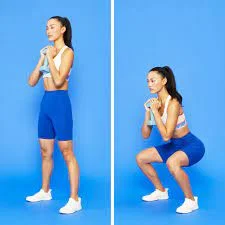
How to do it:
- Stand with your feet hip-width apart.
- With the tiny plate resting on both palms for support, hold the dumbbell bell firmly beneath your chin.
- Keep your elbows tucked down close to your sides, shoulders folded back and braced throughout.
- Lower yourself into a squat stance by pushing your butt back.
- You might need to adopt a broader attitude if you are really constrained.
- As you press your knees out once you’ve reached parallel, use your glutes and quadriceps to stand up again.
Hip Hinge
- The hinge exercise is a helpful warm-up for the harder deadlift exercise. It requires you to bend forward at the hips while maintaining a straight back. The muscles that promote a healthy, neutral spine alignment are strengthened as a result.
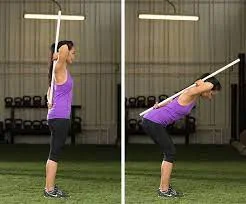
How to do it:
- Hold a broomstick or other straight object vertically behind your back while performing the hip hinge. Place one hand behind your head and the other on your lower back.
- Between your shoulder blades, your tailbone, and your head should all be in contact with the stick.
- Keep the stick in touch with all three of these places while pivoting forward.
Alternating Hamstring Touches
- Strengthens the muscles in the lower back, hamstrings, and core. increases hamstring and lower back flexibility proprioception (the sense of one’s body in space) is improved strengthens the muscles surrounding the knee, ankle, and hip joints, which helps to avoid injury and improves posture.
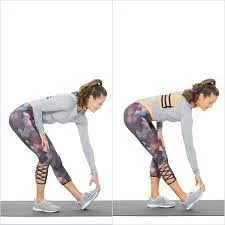
How to do it:
- In Standing Position, maintain a distance between your feet of shoulder width.
- Activate your glutes and core.
- As you squat down, hinge at the hips, and extend both arms in the direction of your right toes.
- While attempting to touch your toes, keep your low back as relaxed as you can.
- Only your hamstrings should be able to detect this.
- Get up and take a standing position.
- Whenever you stoop, this time grasp for your left foot.
- Regain your feet and stand. Then switch sides again.
- With your hands extending towards your right toes, hold at the bottom to do the hamstring stretch pulse.
- As you continue to feel the stretch at the back of the leg, gently pulse your upper body towards your foot while keeping your core tight to prevent back strain. Return to your feet and change sides, bending down and stretching with both arms in the direction of your left foot while vibrating for the same duration.
Alternating Toe Taps
- The muscles in your hip flexors, hamstrings, glutes, calves, and quadriceps are the main targets of toe-tapping. This exercise strengthens your core, reduces back discomfort, improves balance and flexibility, and strengthens your trunk’s rotation, extension, and flexion.
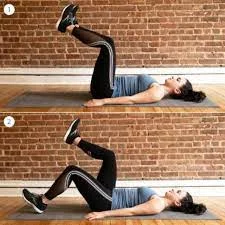
How to do it:
- Your feet should be somewhat broader than shoulder-width apart when you stand.
- Swing your right leg up as parallel to the ground as you can while extending your left arm out in front of you.
- Kick your right hand with your left hand while swinging your right leg back down and putting your foot back in the beginning position.
- Do the opposite side right immediately, extending your right arm in front of you as you kick your left leg till (if possible) your foot contacts your fingertips.
- Make it simpler by picking your right knee to your hip while rotating your body such that your left-hand contacts your right knee, as opposed to kicking up your straight right leg. Bring your hand and foot back to the beginning. Continue by switching sides.
Good Morning
- The excellent morning workout targets the hamstrings, gluteus maximus, erector spinae, and lower back muscles down the back of your body.
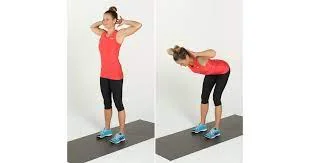
How to do it:
- Place your hands behind your head or at chest level while standing with your feet hip-width apart.
- Your body should collapse forward as you push your butt back and tilt forward at the hips while maintaining a slight bend in your knees and maintaining core stability. Stop when your torso is just out of parallel with the ground.
- Drive your hips forward as you raise your torso back to the starting position. Twist your body to the right while tightening your glutes at the top.
- Repeat the movement, bending at the hips to lean forward and coming back up while twisting your body to the left this time. Immediately after, pull your torso back to the center.
- Continue by switching sides.
Knee Tuck With Slow Rock
- The sitting knee tuck, sometimes referred to as the reverse crunch, is a crucial exercise for your core. Sitting knee tucks are ideal if you want to strengthen your core or develop six-pack abs.
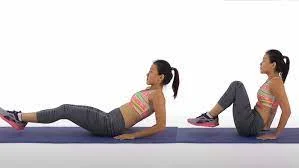
How to do it:
- On your back, lie face up.
- Curl up into a ball by bringing your knees close to your chest.
- Utilizing your hands to draw your knees closer to your chest and your core to elevate your shoulders and neck off the floor, bring your hands to the outsides of your knees.
- You should have your elbows bent and at your sides.
- Rock back and forth to relax your lower back.
Supine Single-Leg Stretch
- All three of these muscles will be used during the supine hamstring stretch, enhancing their flexibility and lowering the chance of injury. Supine hamstring stretches provide additional advantages including lowering low back discomfort, enhancing posture, and speeding up recovery.
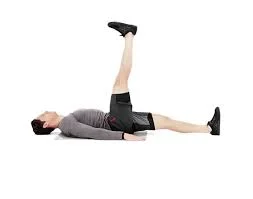
How to do it:
- On your back, lie face up. Bring your right knee to your chest and inhale deeply.
- To bring your right knee closer to your chest, encircle it with your hands.
- Maintain your left leg extended in front of you.
- You keep pulling your right knee in, trying to maintain it level to the ground.
- Your groin should feel stretched.
- Hold one side while alternating to the other.
Reclined Supine Twist
- The reclining twist stance is a fantastic remedy for bad posture problems. It realigns the spine, eases the tension in the shoulders and upper back, and gives the chest and shoulders a nice stretch. Additionally, this position can foster emotions of well-being, connection, and empathy by opening the heart.
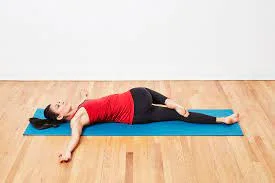
How to do it:
- Arms by your sides while you lie face-up.
- While maintaining your left leg straight on the ground, bring your right knee into your chest.
- Your right knee should be softly guided towards the floor on the left side of your body with the aid of your right hand.
- Even though it limits how far your knee may descend, strive to maintain both shoulders flat on the floor. Your right shoulder might want to lift off the ground.
- On the opposite side, repeat.
Supine Twist With Leg Extension
- Knee-down twists extend the spine, stretch the back muscles, and hydrate the spinal discs.
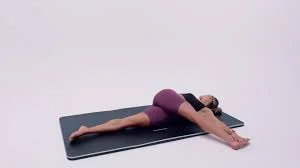
How to do it:
- Arms at your sides while you recline on your back.
- While maintaining your left leg straight on the ground, bring your right knee into your chest.
- To gently move your right knee across your body and towards the floor, use your right hand.
- Even though it limits how far your knee may descend, push to maintain both shoulders flat on the floor. Your right shoulder might want to lift off the ground.
- Now stretch your right leg across your body by straightening your right knee. Hold.
- On the opposite side, repeat.
Seated Spinal Twist
- A pose that supports healthy digestion and spinal mobility is the seated spinal twist. Twisting positions can ease lower back discomfort while toning the abdomen and massaging the internal organs. This position, which is frequently done towards the conclusion of a sequence, is both calming and energizing.
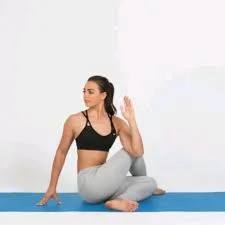
How to do it:
- Stretch both of your legs out in front of you while you sit on the ground.
- Put your left foot outside of your right leg on the ground by bending your left knee.
- Still, keep your right leg straight.
- Turn to the left while extending your right arm.
- So that it continues to advance the twist, lower your arm back down on the outside of your left knee.
- Maintain a straight spine and a back position.
- Hold before completing the motion on the opposite side.
Hip Roll-Out
- Your hips will move more freely as a result of rolling, which also lengthens, stretches, and restores soft tissue suppleness.
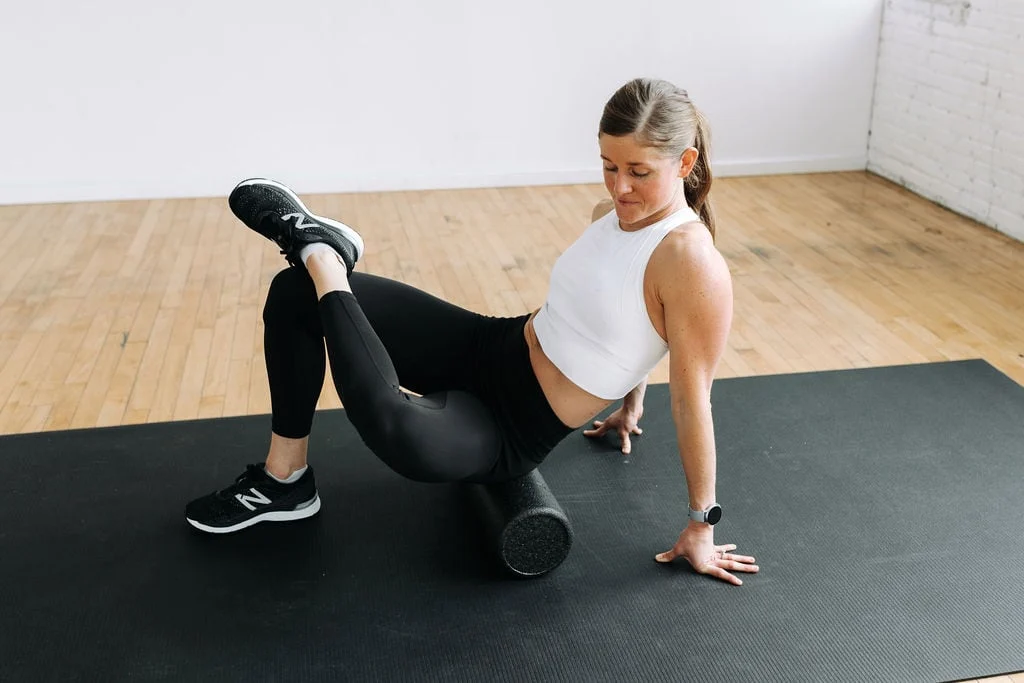
How o do it:
- Kneel on the roller (perpendicular to your body), place your feet flat on the ground, and support your body with your hands on the floor behind you.
- Your left ankle is crossed across your right knee.
- To expand your hip, slant your left knee towards the ground as illustrated.
- Roll back and forth slowly with your right foot.
- To change the intensity, try a couple of slightly different knee angles.
- On the opposite side, repeat the motion.
IT Band Roll-Out
- When you have IT band syndrome, foam rolling can assist to relieve discomfort and tightness, but this relief is just temporary. You must deal with the fundamental reason for your particular instance in order to permanently get rid of it and stop it from returning.
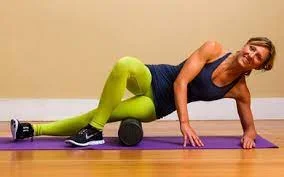
How to do it:
- With your right forearm on the floor and your right leg extended, assume a sitting position on your right hip.
- Place your right thigh on the roller while you sit.
- Aim to position the roller midway between your knee and hip.
- With your left knee bent, place your left foot flat on the ground behind your right leg.
- Extend your left leg as well, stacking it on top of your right leg, to intensify the movement.
- Roll yourself up and down the roller with your right forearm.
- From a few inches above your knee to a few inches below your hip and lower back, you should be rolling your leg. Repeat the movement on the other side.
Good and Bad Workouts for Low Back Pain:
Lower Back Pain: How Exercise Helps
Your back benefits from activity even if you might want to relax. Leg, stomach, and back muscles can all be strengthened with lower back pain exercises. They assist in supporting your spine and relieve back discomfort. Before beginning any workout program for back discomfort, consult a medical expert first. Some activities might not be suggested and even be detrimental depending on the origin and severity of your discomfort.
Lifting Weights May Help
Lifting weights correctly rarely causes back pain. In fact, it could aid in reducing persistent back discomfort. However, exerting more strain on the back’s muscles and ligaments when you are experiencing acute (sudden) back pain increases your chance of future injury. Ask your doctor if you should lift weights and what exercises you should stay away from.
Try: Partial Crunches
When you have severe low back pain, you should avoid certain workouts since they might make your condition worse. Your back and stomach muscles might become stronger with partial crunches. Knees bow down feet flat on the floor as you lay down. Alternatively, you might put your hands behind your neck or cross your arms over your chest. Strike a tight core and lift your shoulders off the ground. As you lift your shoulders, exhale. Never drag your neck up off the floor with your arms or lead with your elbows. After a little pause, carefully bring yourself back down. 8 to 12 times total. Your low back won’t experience too much strain if you use the proper form. You must maintain a firm grasp on the mat with your feet, tailbone, and lower back at all times.
Try: Hamstring Stretches
Bend one knee while lying on your back. Embrace the ball of your foot with a cloth. As you carefully drawback on the towel, straighten your knee. A little stretch should be felt along the back of your leg. Hold for a maximum of 15 to 30 seconds. For each leg, repeat from two to three times.
Try: Wall Sits
When you are 10 to 12 inches from a wall, slant your back so that it is flat against the wall. Put your lower back against the wall as you slowly glide down until your knees are slightly bent. Hold for ten seconds, then slowly climb the wall by sliding back down. 8 to 12 times total.
Try: Press-up Back Extensions
As you hold your shoulders while lying on your stomach, use your hands. Your shoulders will start to rise off the ground as you push with your hands. Put your elbows on the floor under your shoulders if that is comfortable for you, and stay there for a few seconds.
Try: Bird Dog
Tighten your abdomen muscles as you begin on your hands and knees. Leg raised and extended behind you. Sustain level hips. After holding for 5 seconds, go to the opposite leg. Repeat 8–12 times for each leg, extending the length of each lift as much as possible. For each repetition, try lifting and extending your opposing arm. Learn how to keep your low back stable while moving your arms and legs with this workout. Avoid letting your lower back muscles drop while you perform this exercise. Only elevate the limbs as high as necessary to maintain a low back posture.
Try: Knee to Chest
With your knees bent and your feet flat on the ground, you should be on your back. While maintaining the other foot level on the ground, lift your knee to your chest. Hold for 15 to 30 seconds with your lower back pushed firmly to the floor. Next, bend your knee and do the same with your opposite leg. Repeat this for each leg 2 to 4 times.
Try: Pelvic Tilts
Lie on your back with your legs bending over with feet flat on the ground. As though you were getting ready to take a punch, tighten your midsection. Your hips and pelvis will move back and your back will press against the floor. Hold for 10 seconds while inhaling and exhaling easily. 8 to 12 times total.
Try: Bridging
Lie backward with your legs bent and only your heels touching the ground. As soon as your shoulders, hips, and knees are in a straight line, press your heels into the ground, tighten your buttocks, and lift your hips off the ground. Hold for approximately 6 seconds, then slowly drop your hips to the ground and take a 10-second break. 8 to 12 times total. As your hips rise, try to keep your lower back from arching. By tensing your abdominal muscles before and throughout the lift, you may prevent overarching.
Try: Aerobic Exercise
You may reduce weight by engaging in aerobic activity, which also improves your heart, blood vessels, and lungs. Walking, swimming, and biking can all help to relieve back pain. Start with brief sessions and gradually increase. If you’re experiencing back pain, consider swimming, where the water supports your body. Do not use any body-twisting motions.
Try: Some Pilates Moves
Pilates involves abdominal, stretching, and strengthening movements. It could be beneficial for some persons with back discomfort when taught by a qualified instructor. In order to avoid certain motions, make sure to let your teacher know if you suffer from back discomfort.
Avoid: Toe Touches
Exercise can help with low back discomfort, but not all forms of exercise are helpful. As muscles get stronger, any little soreness experienced at the beginning of these workouts should go away. However, patients should stop exercising and call their physician if the discomfort is more severe and lasts for more than 15 minutes while they are exercising. Some workouts could make soreness worse. For instance, standing toe touches place more strain on your spine’s discs and ligaments. They could also overstretch the lower back and hamstring muscles.
Avoid: Sit-ups
Even while you might think that performing sit-ups will improve your core or abdominal muscles, the majority of people really activate their hip muscles when performing sit-ups. The discs in your spine may experience a lot of strain with sit-ups as well.
Avoid: Leg Lifts
Sometimes it’s recommended to perform leg lifts in order to “strengthen your core” or abdominal muscles. While elevating both legs at once while resting on your back is quite taxing on your core, exercising to strengthen your lower back may be very useful in reducing discomfort. This workout may exacerbate back discomfort if you are weak. Try resting on your back instead, keeping one leg straight and the other bent at the knee. maintaining a flat back on the floor. Lift the straight leg slowly and hold for a few seconds. Slowly lower the leg. Ten repetitions later, exchange legs.
Best Lower Back Workout In The Highlight Reel:
- Despite being essential to almost every significant exercise you perform, the lower back is one of the body parts that is most usually overlooked when it comes to training.
- Your low back should be strong and stable, supporting your entire body. However, prolonged sitting and poor posture weaken this area, making it more prone to pain.
- Strengthening requires the lower back and glutes to work together.
- These two muscle groups work best when they are together.
- I’ve provided a thorough plan with 4 exercises that you can do at home with no equipment to increase lower back strength that will transfer to your large lifts.
- You may carry out these lower back exercises on a regular basis to help repair the issues that have arisen over time.
Lower Back Exercise Advice:
Muscles primarily perform as muscles. However, some portions of your body require a more delicate and exact touch than others, whether you’re doing out to enhance your general health or attempting to add muscle.
You might be hesitant to train your lower back directly, even for bodybuilding. This is quite normal. If you keep these recommendations in mind, you won’t have any anxiety.
Warnings:
Always with a physician before beginning a new exercise regimen.
After experiencing a traumatic injury from a fall or accident, always seek medical care and extra testing to rule out more serious issues.
If your back pain worsens, stop completing these exercises and seek medical treatment.
Work only to the extent of your physical limitations. Overextending oneself can exacerbate back pain and delay the recovery process.
What to remember:
Low back strengthening exercises are an excellent way to prevent low back pain from returning.
Stronger core muscles have a positive impact on function, stability, and injury prevention.
Changes to daily activities, such as picking up items while standing rather than crouching, can also help lessen low back pain and muscle spasms.
Start incorporating these short, no-equipment exercises into your daily routine right now, and you’ll start seeing benefits right away.
Common Training Mistakes in Back Workouts
Learn to avoid these frequent lower-back training mistakes if you want to strengthen your lower back:
- Having Poor Posture
It’s simple to arch your back when carrying out a lower-back workout. Your risk of injury is significantly increased if your upper back posture is bad.
Every time you perform a back exercise, roll your shoulders back and down and compress your abdominals. Additionally, by strengthening your upper-back muscles with exercises like face pulls, scapular retractions and dumbbell shrugs, you can keep your shoulders from hunching.
- Lifting Too Heavy Of a Weight
It is significantly more vital to lift modest weights with good form than it is to raise huge weights.
Keep in mind that one of the most frequent injuries in the weight room is a lower-back injury. Prior to adding weight to the bar, perfecting your form is the greatest way to prevent injuries.
- Skipping The Warm-Up
Before beginning any strength training program, you should warm up.
Start with a dynamic warm-up that includes singing, high knees, and glute kicks. Start doing back stretches like the cat-cow. Do bodyweight variations of the aforementioned exercises, good mornings using a PVC pipe, or bodyweight squats and deadlifts as a last workout.
- Not Resting Enough Between SETS
Take two to three minutes between sets while performing heavier movements, such as deadlifts and squats. Your muscles get enough time to relax as a consequence.
Also, make sure you allow yourself enough downtime in between sessions. Your muscles will recover after a difficult lift if you consume a post-workout recovery smoothie with whey protein powder.
Lower Back Pain – Red Flags and How to Correct It
Extremely common is lower back discomfort. While building up the muscles in your lower back might assist with some problems, there are additional warning signs to watch out for that could potentially be causing pain. Fortunately, there are a few rather easy fixes for these warning signs.
- Check your Hip Flexors
The most typical cause of lower back discomfort is tight hip flexors. A collection of muscles and tendons known as hip flexors link to the lumbar vertebrae in your back and descend to the front of your hips. Your knees can be brought up to your chest, and you can bend at the waist. Numerous factors, including abdominal workouts and prolonged periods of sitting, can cause tightness in this region. The Thomas Test can be used to determine these muscles’ flexibility. As you recline on a bench, hold onto one leg and draw it close to your chest. Is the other leg able to rest flat on the bench? If not, your hip flexors are definitely tight. The easiest approach to deal with this is to make sure you stretch the region often. Include stretches like the figure four, sitting butterfly, and pigeon position in your cool-down routine.
- Your Glutes are Too Weak
Your back muscles receive a lot of functional assistance from your glutes. Too much strain and tension on the lower back might result from having weak butt muscles. Checking your glutes is most easily accomplished by taking a side profile in the mirror. How’s the booty game going? The better the support for your back, the more sculpted and defined your butt is. A hyper-hold test is another helpful procedure. To keep your body upright for at least two minutes without cramping or failing, use a ham-glute machine. If you’re not able to achieve this, consider adding extra glute workouts to your regimen.To increase your endurance, you may maintain performing hyper-holds or attempt movements like hip thrusts, split lunges, or barbell RDLs.
- Standing for more than 20 minutes causes you pain or dizziness
The last warning sign may need to be noticed by you. Can you remain motionless for 20 minutes without moving or feeling any pain? You need to focus on your lower back muscles’ endurance if your standing posture resembles dancing more often than not. The exercises mentioned above are an excellent place to start. With hyper-holds, you may also increase the length gradually while increasing your tolerance. Your pelvis’ position should also be checked. Do you have a protruding butt due to an anterior pelvic tilt? If you do, it can also result in a lack of endurance. Fortunately, you may use several exercises to improve your posture in the lower body.
How Does Exercise Help in Lower Back Pain Relief?
- One might experience stiffness and soreness in the lower back when exercising. While one is exercising, the discs can interchange fluids and get the nutrients that they need. A healthy disc functions similarly to a sponge, absorbing water and squeezing it out.
- Additionally, these fluid exchanges aid in lowering swelling in various soft tissues that develop around damaged discs. Lack of activity causes the swelling to spread and the discs to become malnourished and degenerated.
- Exercise keeps the connective fibers of tendons and ligaments flexible, which reduces back pain and stiffness. Exercise also increases mobility, which in turn lowers the risk of injury and back discomfort by preventing the connective tissues from rupturing under stress. Additionally, physical activity stretches, strengthens, and heals the muscles that support the back.
Benefits of Having a Strong Back
- Strength in the lower back is more about function than form because of the depth and intrinsic structure of the muscles in that region. Although they won’t make you look nice on the outside, these muscles will help you stay healthier. Many factors contribute to lower back discomfort, including sedentary work, bad posture, and using the wrong technique when exercising or participating in sports. A healthy lower back will be able to withstand them and avoid harm. Additionally, you’ll be able to improve your performance in the weight room and in other activities like hockey, rugby, or jogging. Additionally, having healthy, strong lower back muscles can help you maintain your mobility as you age, allowing you to dance until you’re elderly.
- A Body with More Balance
Without a big upper back and shoulders, a big chest looks ridiculous (and doesn’t physically work very well). Similarly, your abs are a component of your core, which is ultimately responsible for supporting your spine. Your mid and lower back require treatment for both improved function and appearance.
- Better back strength, better posture
Everyone likes to stand up straight when they look in the mirror; thus, the postural correction that comes from strong, activated back muscles is important.
- Having a strong back makes you stronger overall
Your back muscles are made up of your traps, lats, delts, rhomboids, erector spinae, and other posterior chain-related muscles. There are several reasons to target those muscles directly, but your back muscles may also contribute more than you might think to support powerful compound motions that pay off well, like the bench press. Your upper and middle back muscles aid in shoulder joint stabilization, and the more powerful and stable your shoulders are, the more weight you can carry during nearly all upper-body exercises. Don’t be surprised if all those rows result in stronger arm muscles because your hands must be included in workouts that focus on your back to carry the strain as well.
- A V-Taper
Are you concerned with your front because you desire to have a V-shaped torso? Without focusing on the rear, you won’t make it there. Check out this exercise if that’s what you’re after, but you should likely be inspired to look beyond simply getting that.
Injury or chronic pain? When to Visit a Physician First
Strengthening the lower back muscles, more especially by focusing on your lower back and core, is one of the greatest strategies to minimize pain in your lower back. There are workouts that are effective for building up the major back muscles as well as the deep core muscles. Before moving on, let’s halt and state categorically.
Before starting an exercise regimen (even with a personal trainer), consult your doctor or a physical therapist if your back discomfort is severe or chronic. If you experience severe lower back pain, you may have spinal stenosis or another damage that calls for an X-ray or other diagnostic procedures. If you have acute pain rather than dull or persistent back discomfort, make an appointment with a doctor right once. When you have spinal stenosis, the sciatic nerve and compressed intervertebral discs are affected, therefore it’s crucial to discuss your alternatives with a healthcare professional, such as physical therapy. And if you feel lower back pain while performing this exercise or any other exercise, stop immediately and schedule a visit with a medical professional.
FAQs
The Multifidus, Longissimus, Spinalis, and Quadratus Lumborum are among the lower back’s muscles. In order to raise intra-abdominal pressure, the low back muscles and transverse abdominal muscles collaborate.
Your muscles should be able to move through their complete range of motion to develop a strong lower back. Numerous studies have demonstrated that even for highly trained individuals, using only one lower back exercise 1-2 times per week will considerably and quickly boost lower back strength.
Since the muscles of the lower back are deep and supported by other superficial muscles, such as the abs and glutes, strengthening it can be challenging. Working the muscles through their whole range of motion, including isometric and concentric contraction, is the greatest approach to increasing strength. Try deadlifts, kettlebell swings, bridges, supermans, and hyperextensions. Some of these exercises target the lower back specifically, but others use it as part of a bigger compound action.
The regions and your core will be strengthened with the greatest workouts for lower back pain. Try bridges, supermans, crunches, and pelvic tilts, among other exercises. You may try larger movements like hyperextensions, deadlifts, and kettlebell swings once you’ve relieved some of the soreness. Stretching is a fantastic approach to relax the muscles and relieve back discomfort. Excellent stretches include child’s pose, knees to chest, cat/cow, and rotational stretches.
Lower back pain sufferers have an excellent low-impact workout choice in walking. It can help you keep a healthy weight, improve your posture, and strengthen the back muscles. Additionally, walking will stretch the muscles in your legs, glutes, and back, which will increase blood flow and aid in muscle healing. Additionally, walking may be an excellent way to take in some fresh air, get a nice dose of vitamin D, and relax.
Because they strengthen the entire region, including the back, glutes, and legs, squats can help reduce back discomfort. However, they must be done properly; otherwise, bad form might result in additional harm. Try front-weighted squats with a kettlebell or goblet if you’re unsure. By doing so, you’ll be able to sink into your natural center of gravity and make sure no tension is placed where it shouldn’t be. Furthermore, you should concentrate on sinking straight down rather than moving your hips forward or back.

